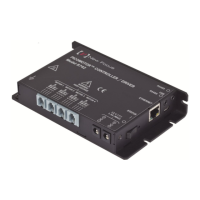28 Theory of Operation
3.4 Power Supply
The 8742 Controller/Driver can place stress on the system power supply. The stress
has two components:
Inrush current: The inrush current on power-up charges the internal filter
capacitor. While the energy magnitude of the inrush current is limited, it can still
cause problems with power supplies not designed to handle it.
Dynamic load: Dynamic current is supplied to the 8742 internal power supply for
each Picomotor drive pulse. The input-filter capacitor will supply more dynamic
current as the resistance between the capacitor and system power supply increases.
Do not increase this resistance: it will increase ripple-current stress on the internal
input-filter capacitor, leading to early failure of the Model 8742. The best strategy is
to keep the resistance between the power supply and the 8742 below 0.1 Ω and use
the power supply recommended by New Focus that came with the 8742
Controller/Driver.
3.4.1 Fault Protection
The 8742 Controller/Driver incorporates circuit-protection schemes to protect itself
and the system power supply:
Over-voltage protection: If the power input voltage exceeds 16.7 to 18.5 V, a
transient voltage suppressor (TVS) shunts the power input to ground. The internal
2.5 A fuse will then open. The TVS will also shunt the power input to ground if an
internal fault shorts any high voltage to the power input. The input fuse will also
open if the input power voltage is reversed. Brief power supply transients will not
blow the fuse. Therefore, it is highly recommended to use the correct New Focus-
supplied power supply. If the fuse was blown, the unit has to be serviced by New
Focus. It is not user replaceable.
Over-temperature protection: If the base plate of the unit reaches 80 °C, the unit
will turn the status indicator solid red to tell the user that the base plate, which acts
as a heatsink, reached the maximum allowed temperature. The user is expected to
take some measures like decreasing the pulse rate, force-air cool the 8742 case, or
use an extra heatsink. If the case temperature continues to rise, at 85 °C the output
will be turned off. The output will remain off until the base plate temperature
decreases to 75 °C, when the output will be ready to drive the motor again. In that
case the status indicator will turn solid green to indicate that the normal operation
has resumed (see
Table 1). If left unattended, the unit will protect itself cycling
between 85 °C and 75 °C.
The unit does not need an extra heatsink in normal laboratory environment.
However, if forced cooling is needed, usually at high ambient temperatures, a
heatsink can be mounted using the 4 slots of the unit base (see Figure 14).

